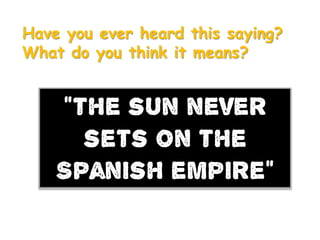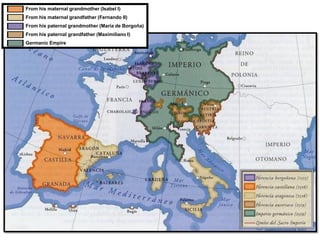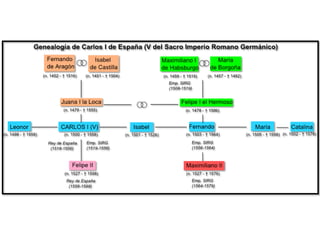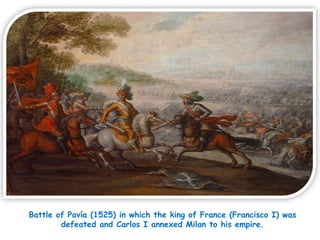U8. spanish hegemony 16 century
- 1. UNIT 8 SPANISH HEGEMONY IN THE 16TH CENTURY 2ºESO Teacher: Rocío Bautista
- 2. 1st Millenium BC PRE-ROMAN PEOPLE: - Phoenicians, Greeks, Carthaginians, Tartessians. - Iberians, Celts. 3rd Cent. BC – 476 AD ROMAN HISPANIA 476 – 711 VISIGOTH KINGDOM 711 – 1492 Coexistence of...: - AL-ANDALUS (south) - CHRISTIAN KINGDOMS (north) 1479 – 1516 CATHOLIC MONARCHS (dynastic union of the Crowns of Aragon & Castilla) 1516 – 1700 HABSBURG DINASTY: 16th Century: - Carlos I - Felipe II 17th Century: - Felipe III - Felipe IV - Carlos II Chronological axis Spanish history ANCIENT HISTORY MIDDLE AGES MODERN AGE
- 3. KINGS OF SPAIN DURING THE MODERN AGE (UNTIL 1700)
- 4. “the sun never sets on the Spanish empire” Have you ever heard this saying? What do you think it means?
- 5. 1. The early modern period in Spain Modern Age in Spain = began with the Catholic Monarchs, who took the 1st steps towards the Spanish hegemony in Europe (consolidated in the 16th century by Carlos I & Felipe II). 1469: marriage between Isabel I of Castilla & Fernando II of Aragon Isabel proclaimed herself Queen of Castilla in 1474 when her brother (Enrique IV) died, and consolidated her position in 1479 (Treaty of Alcaçovas end war against Juana la Beltraneja: Castilla for Isabel & hegemony in the Atlantic for Portugal). Fernando became King of Aragon in 1479 when his father (Juan II) died. 1479: dynastic union of Castilla and Aragon: Each had their own institutions, laws & monetary systems They only had in common the monarchs & some common aims
- 6. COMMON AIMS FOR BOTH CROWNS RELIGIOUS UNITY · Created the Tribunal of the Inquisition (1478) · Jews & Muslims were forced to convert to Christianity or leave. ESTABLISHMENT OF AN AUTHORITARIAN MONARCHY · IMPOSING THEIR AUTHORITY... - Reducing power of nobles & autonomy of cities (Corregidores to impose royal authority in cities) - Summoning the Cortes as little as possible · IMPROVING THE ADMINISTRATION... - Creating Councils made up of experts in different topics, chosen by the king to advise him. - Collecting taxes regularly - Organizing a professional army & creating the Santa Hermandad (police for the countryside) · ENLARGING THEIR DOMINION WITH A STRONG COMMON FOREIGN POLICY... - Aragon’s Mediterranean Expansion Naples, Sicily, Sardinia & the Rousillon. - Castilla’s Atlantic Expansion territories in Africa (Melilla), Canary Islands & America TERRITORIAL UNITY · 1492: Nasrid Kingdom of Granada. · 1512: Kingdom of Navarra. · Prepared a future union with Portugal through marriage alliances (not effective until 1580 with Felipe II)
- 7. COUNCILS TO ADVISE KINGS IN DIFFERENTS ASPECTS (“POLISINODIAL SYSTEM”). THEREFORE, THE “CORTES” ARE INCREASINGLY LOSING IMPORTANCE.
- 8. THE CAPITULATION OF GRANADA (Boabdil el Chico, the last emir of Granada, hands over the keys of the city to the Catholic Monarchs on the 2nd of January 1492)
- 9. ARRANGEMENT OF STRATEGIC POLITICAL MARRIAGES BY THE CATHOLIC MONARCHS
- 10. MEDITERRANEAN & ATLANTIC EXPANSION OF THE CATHOLIC MONARCHS. THEIR STRONG FOREIGN POLICY SET THE FOUNDATIONS OF THE SPANISH EMPIRE
- 12. Activity 1: P. 137 exercises 3, 4 Who took the first steps towards the Spanish hegemony in Europe and the creation of the Hispanic Empire? When was it consolidated? How did the Catholic Monarchs achieved the territorial unity? Define: • Corregidores • Santa Hermandad • Tribunal of the Inquisition • Councils (“Consejos”)
- 13. 2. Spanish hegemony Isabel & Fernando reigned together until her death (1504). From that year onwards: Aragon continued to be ruled by the king Fernando Castilla ruled by Juana la Loca (daughter of the Catholic Monarchs) & Felipe el Hermoso (son of the German Emperor, Maximiliano I of Austria). When Felipe died (1506), Juana was declared mentally ill and confined in a castle in Tordesillas (Valladolid), and her father Fernando ruled Castilla in her name until he died (1516).
- 15. LA REINA DOÑA JUANA "LA LOCA", RECLUIDA EN TORDESILLAS CON SU HIJA, LA INFANTA DOÑA CATALINA (1906, Francisco Pradilla. Prado Museum)
- 16. The reign of the two first Habsburgs (Carlos I & Felipe II) meant the hegemony of Spain: it became the most powerful country in Europe with dominions all over the world.
- 17. Carlos I of Spain and V of Germany 1516: became king of Spain when his maternal grandfather, Fernando el Católico, died. 1520: became German Emperor when his paternal grandfather, Maximiliano I, died. He accumulated a huge inheritance!!!
- 18. Carlos I of Spain and V of Germany INHERITANCE OF CARLOS I: From his maternal grandmother (Isabel I of Castilla): Castilla, Navarra, and the new territories in Africa & America. From his maternal grandfather (Fernando II of Aragon): Aragon, Naples, Sicily, Sardinia & the Rousillon. From his paternal grandmother (María of Borgoña): Low Countries (Flanders) & the Franco Condado. From his paternal grandfather (Maximiliano I of Austria): territories in Austria & title of German Emperor.
- 19. From his maternal grandmother (Isabel I) From his maternal grandfather (Fernando II) From his paternal grandmother (María de Borgoña) From his paternal grandfather (Maximiliano I) Germanic Empire
- 21. Activity 3: design a genealogical tree of Carlos I. Include: his grandparents, his parents, his wife (Isabel de Portugal) and his son. Activity 2: colour in a map of the inheritance of Carlos I. Include a legend to specify which territories were inherited from each of his grandparents.
- 23. Carlos I of Spain and V of Germany In Castilla Revolt of the Comuneros. In Aragon Revolt of the Germanías. France Turks (Ottoman Empire) Protestants INTENAL CONFLICTS EXTERNAL CONFLICTS
- 24. Carlos I of Spain and V of Germany a) INTERNAL CONFLICTS: When he arrived in Spain (1517), he was seen as a foreigner: Born and raised in the Low Countries. Couldn't speak Spanish. Chose Flemish councillors for high posts, instead of Spaniards. Increased taxes to finance foreign issues. 1520-21: the discomfort with the new foreigner king led to 2 revolts: In Castilla Revolt of the Comuneros In Aragón Revolt of the Germanías
- 25. Popular revolts aroused in Castilla & Aragon due to the disagreement with the new king.
- 26. “Execution of the Comuneros of Castilla” (Antonio Gisbert, 1860). Depicts the beheading of the leaders of the revolt (Juan de Padilla, Juan Bravo y Francisco Maldonado), who were defeated in the battle of Villalar (1521)
- 27. Carlos I of Spain and V of Germany b) EXTERNAL CONFLICTS: Carlos I was in constant war against... France: which was surrounded by Habsburgs’ territories. They fought over control of north Italy Carlos I annexed Milan. The Turks (Ottoman Empire): who were a threat in Central Europe & the Mediterranean. Carlos I annexed Tunis The protestants: some German princes converted to Lutheranism, and demanded autonomy from Charles I. After many years fighting, Carlos I recognised religious freedom in Germany (Peace of Augsburg, 1555)
- 28. Battle of Pavía (1525) in which the king of France (Francisco I) was defeated and Carlos I annexed Milan to his empire.
- 29. The Conquest of Tunis (1535), then under the control of the Ottoman Empire, by the Spanish Empire.
- 30. Carlos I added Milan & Tunis to the Spanish Empire
- 31. PEACE OF AUGSBURG (1555) Representatives of the German estates at the Augsburg conference discuss the possibilities of a religious peace. The front page of the treaty: each prince could chose the religion in his dominions
- 32. Carlos I of Spain and V of Germany 1556: tired of so many conflicts, Carlos I abdicated the throne and retired to Extremadura (Monastery of Yuste) where he died in 1558. The Spanish Empire (Spain, Spanish territories in America, the Low Countries, Naples, Sicily…) to his son Felipe II German Empire to his brother Fernando.
- 33. ”Abdication of Carlos V” (L. Gallait, 1841). It depicts the abdication of Carlos V on the 25th of October 1555 in the imperial palace of the Low Countries (Brussels).
- 35. Activity 5: match the following dates & events, and draw a chronological axis with them: DATES: 1516 / 1517 / 1520 / 1520-21 / 1555 / 1556 / 1558 EVENTS: • Peace of Augsburg. • Carlos I becomes emperor of the German Empire. • Death of Carlos I. • Abdication of Carlos I. • Fernando II dies and Carlos I becomes king of Spain. • Popular revolts in Castilla & Aragón (Comuneros & Germanías). • Carlos I moved from the Low Countries to Spain where he isn’t well received. Activity 4: explain the main external conflicts that Carlos I had to confront, and the territorial/political consequences that they had.
- 36. Felipe II 1556: inherited the Spanish Empire (Spain, Spanish territories in America, the Low Countries, Naples, Sicily…) from his father. Since he wasn’t the German Emperor, he governed in Spain’s benefit. To do so, he established a permanent court in Madrid (1561), which became the capital of Spain.
- 37. Felipe II Revolt of the Moriscos (“Revuelta de las Alpujarras”) France Turks (Ottoman Empire) Protestants in the Low Countries England Annexation of Portugal INTERNAL CONFLICTS EXTERNAL CONFLICTS
- 38. a) INTERNAL CONFLICTS: 1568 Revolt of the Moriscos (“Revuelta de las Alpujarras”) in Granada Cause: the “Pragmatic Sanction” that pressured the Moriscos (Muslims converted to Christianity) to abandon their culture: Forbid Arab culture (language, clothes, music, baths, names…). Forced them to learn Spanish. Consequence: Felipe II put an end to the revolt. The Moriscos who survived were dispersed to other cities of Spain to avoid new revolts. Felipe II
- 39. Places where the “moriscos” rebelled against the Pragmatic Sanction.
- 40. b) EXTERNAL CONFLICTS: Felipe II was also in constant war against... France: the French invaded Naples, so the Spanish army in the Low Countries counterattacked invading France. The French were decisively defeated in the Battle of San Quintín. The Turks (Ottoman Empire): Felipe II allied with Venice & the Pope and formed a fleet (“Holy League”) which defeated the Turks at the Battle of Lepanto. ... Felipe II
- 41. BATTLE OF SAN QUINTÍN France VS Spain It ended the 10th of August 1557, festivity of San Lorenzo (a saint who was burned to death in a grill). To conmemorate this victory, Felipe II built the “Monastery of San Lorenzo de El Escorial”... Noticed that it has the shape of a grill?!?
- 42. BATTLE OF LEPANTO (1571) Catholics (Holy League) VS Ottoman Turks Do you know who “El Manco de Lepanto” is?
- 43. ... The protestants in the Low Countries: Felipe II seen as a foreigner by the Flemish (born in Spain, court in Madrid...) + expansion of Protestantism... Flemish rebelled demanding autonomy. The northern Low Countries declared themselves independent forming the United Provinces (1579), but the war continued. England: due to the English support to the Dutch, English piracy against Spanish ships that came from America & Anglicanism. Felipe II planned the invasion of England by sending the “Armada Invencible” Spain’s first major defeat. Another important event was the Annexation of Portugal (1580) Felipe II
- 44. EIGHTY YEARS WAR Spain VS United Provinces (northern Low Countries) In 1579 the northern provinces of the Low Countries, mostly Protestant, declared themselves independent creating the “United Provinces” (Union of Utrecht). The southern provinces, mostly Catholic, remained loyal to Felipe II (Union of Arras) in order to receive protection against Protestants’ attacks. However, the war between Spain and the protestants of the United Provinces continued until 1648. (Eighty Years War: 1566- 1648. Felipe IV recognized their independence in the Peace of Westfalia).
- 45. The Spanish Armada wasn’t able to invade England due to the bad weather, it wasn’t possible to pick up the soldiers from the Low Countries (which were suffering the Protestant rebellion), food rotted (since the wood was still humid)…
- 46. The Spanish Empire under Felipe II after the annexation of Portugal (1580)
- 47. 1598: the died in the Monastery of San Lorenzo de El Escorial, being succeeded by his son Felipe III. Felipe II “Last moments of Felipe II”. Francisco Jover y Casanova
- 48. Activity 6: • P.138 exercises 1 / 2 • Define: - Battle of San Quintín - Battle of Lepanto • Explain why did the “Armada Incencible” failed.
- 49. 5. Politics, economy & society SPANISHMONARCHY •Carlos I & Felipe II: authoritarian monarchies: - Directly exercised power. - Assisted by secretaries, councils & administration. - Limited others’ power. •Army = very important due to constant wars. Organized in tercios. •Each territory maintained its own laws, institutions... Governed by a viceroy (represented the king). POPULATION&ECONOMY SOCIALGROUPS
- 51. The Spanish “Tercios”: Spanish military units composed of 3,000 soldiers. They were based on the combination of different weapons: musket (mosquete), harquebus (arcabuz) & pike (pica).


















































